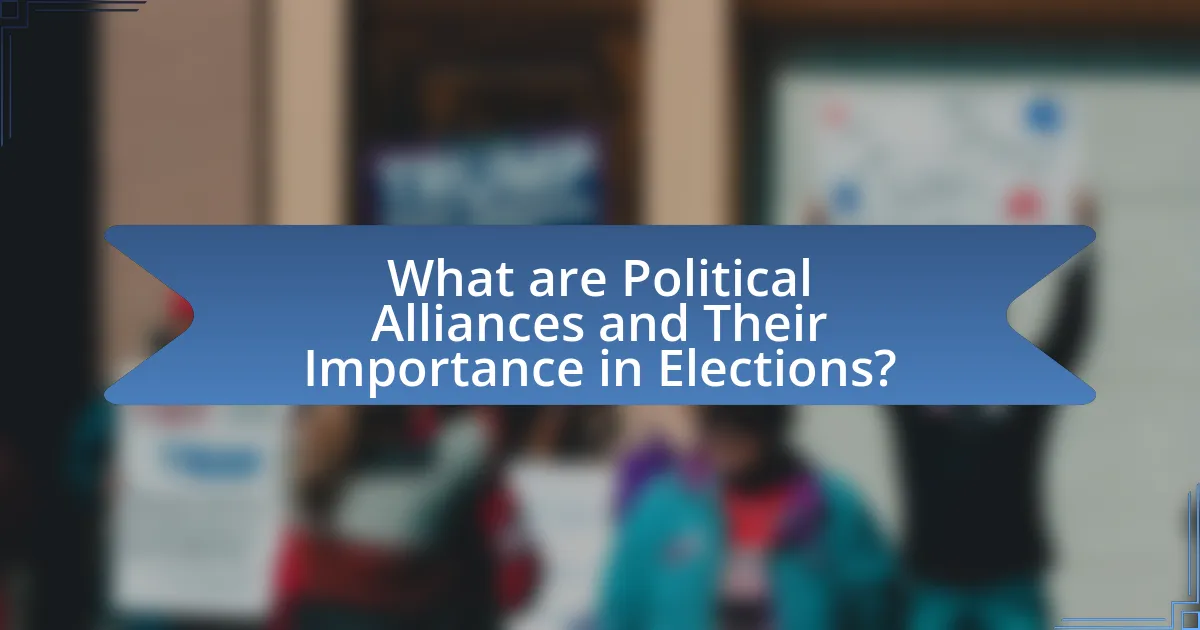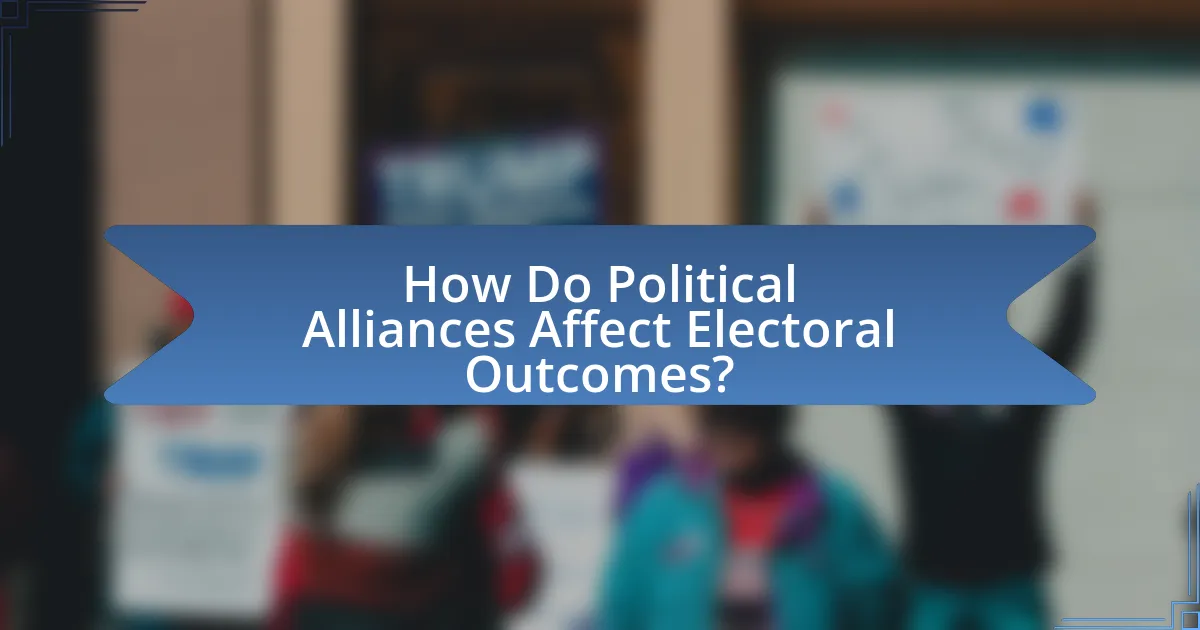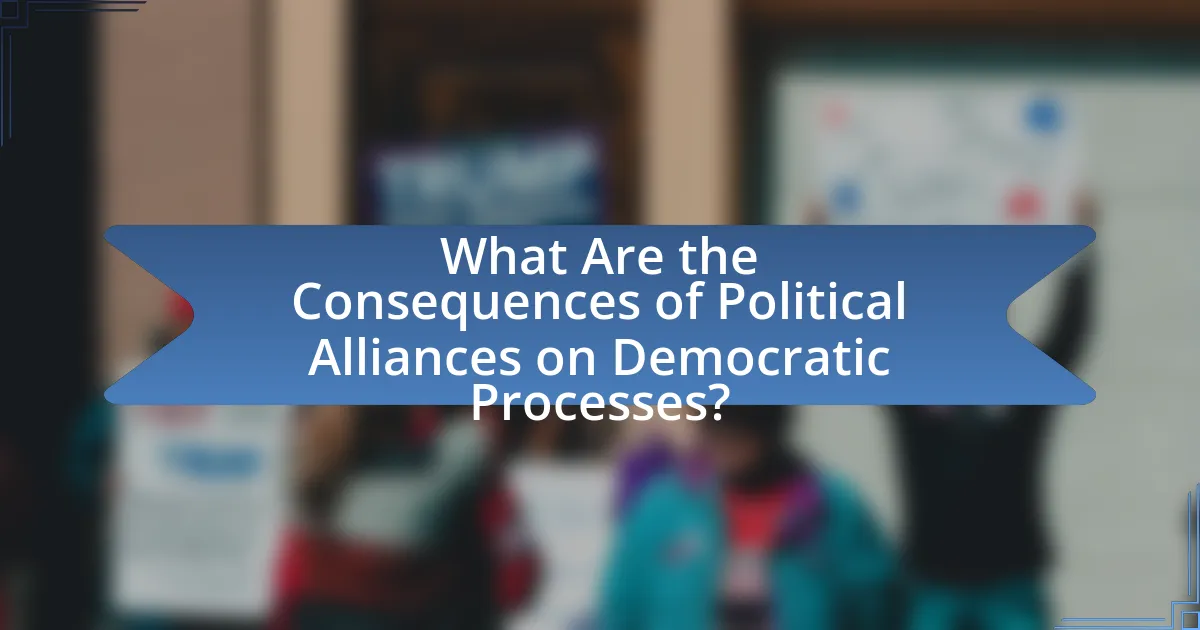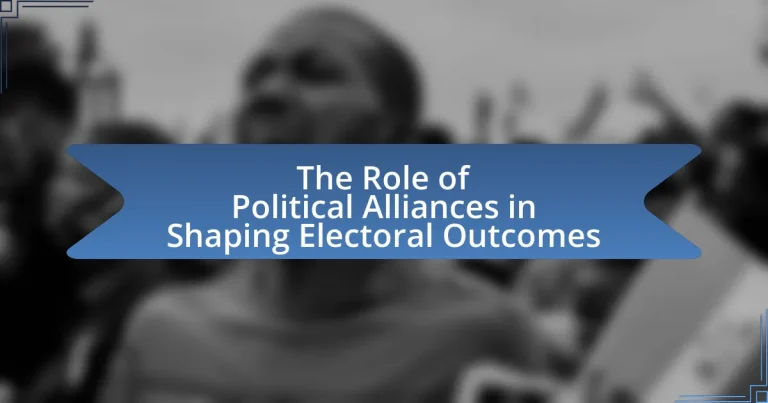Political alliances are formal agreements between political parties or groups aimed at collaboration, particularly during elections, and play a crucial role in shaping electoral outcomes. This article examines the significance of political alliances in consolidating votes, influencing voter behavior, and enhancing resource mobilization. It explores various types of alliances, including formal and informal, and discusses their impact on candidate perceptions, election strategies, and coalition governance. Additionally, the article addresses the challenges and risks associated with political alliances, such as corruption and electoral manipulation, while highlighting best practices for fostering effective partnerships in the political landscape.

What are Political Alliances and Their Importance in Elections?
Political alliances are formal agreements between political parties or groups to collaborate for mutual benefit, particularly during elections. These alliances are crucial as they can consolidate votes, enhance resource sharing, and increase the chances of winning seats by presenting a united front against opponents. For instance, in the 2016 U.S. presidential election, the Democratic Party formed alliances with various progressive groups to mobilize a broader voter base, which significantly impacted voter turnout and engagement. Such strategic partnerships can also help smaller parties gain representation by aligning with larger parties, thereby influencing policy agendas and electoral outcomes.
How do Political Alliances Influence Voter Behavior?
Political alliances significantly influence voter behavior by shaping perceptions, mobilizing support, and consolidating resources. When parties form alliances, they often present a united front that can enhance credibility and appeal to a broader electorate. For instance, in the 2019 Indian general elections, the National Democratic Alliance (NDA) successfully consolidated votes by uniting multiple regional parties, which led to a significant increase in their overall vote share. This demonstrates that alliances can effectively sway undecided voters and reinforce loyalty among existing supporters, ultimately impacting electoral outcomes.
What psychological factors drive voter support for political alliances?
Psychological factors that drive voter support for political alliances include social identity, perceived group cohesion, and trust in leadership. Social identity theory suggests that individuals align with political alliances that reflect their own social identities, leading to increased support for parties that resonate with their values and beliefs. Perceived group cohesion enhances voter loyalty, as individuals feel a sense of belonging and solidarity with the alliance. Trust in leadership is crucial; voters are more likely to support alliances led by figures they perceive as competent and trustworthy. Research indicates that these psychological factors significantly influence electoral behavior, as demonstrated in studies showing that voters are more likely to support coalitions that align with their social identities and exhibit strong leadership.
How do alliances shape perceptions of candidates among voters?
Alliances significantly shape perceptions of candidates among voters by influencing the credibility and appeal of those candidates. When candidates form alliances with established political figures or organizations, they often gain enhanced legitimacy and trustworthiness in the eyes of voters. For example, a candidate endorsed by a popular political leader may be perceived as more competent and aligned with the values of that leader’s supporters. This phenomenon is supported by research indicating that endorsements can increase a candidate’s favorability ratings by as much as 20% among targeted voter demographics. Additionally, alliances can create a perception of unity and strength, suggesting that a candidate has the backing necessary to effectively govern, which can sway undecided voters.
What Types of Political Alliances Exist?
Political alliances can be categorized into several types, including formal alliances, informal alliances, electoral coalitions, and issue-based coalitions. Formal alliances are established through official agreements, often seen in party mergers or federations, such as the European People’s Party in Europe. Informal alliances are less structured and may arise from mutual interests or shared goals, often seen in legislative bargaining. Electoral coalitions are temporary alliances formed specifically for elections to maximize votes, like the coalition formed by various parties in the 2019 Indian general elections. Issue-based coalitions unite parties around specific policy goals, such as environmental protection or social justice, exemplified by the Green Party alliances in various countries. These classifications illustrate the diverse strategies political entities employ to enhance their influence and electoral success.
What are the differences between formal and informal alliances?
Formal alliances are structured agreements between political entities that involve specific terms, roles, and responsibilities, while informal alliances are more flexible, based on mutual understanding and cooperation without formal commitments. Formal alliances often include written contracts or treaties, such as coalition agreements in parliamentary systems, which outline the obligations of each party, whereas informal alliances may arise from shared interests or goals, relying on trust and verbal agreements. The distinction is significant in electoral contexts, as formal alliances can lead to strategic voting and resource sharing, while informal alliances may facilitate grassroots mobilization and adaptability in response to changing political landscapes.
How do ideological alliances differ from strategic alliances?
Ideological alliances differ from strategic alliances primarily in their foundational motivations; ideological alliances are based on shared beliefs and values, while strategic alliances focus on mutual benefits and pragmatic goals. Ideological alliances often emerge in political contexts where groups unite around common ideologies, such as socialism or conservatism, influencing electoral outcomes by mobilizing voters who resonate with those beliefs. In contrast, strategic alliances are formed to achieve specific objectives, such as winning elections or gaining legislative power, regardless of the underlying ideologies of the parties involved. For example, a coalition formed to secure a majority in a parliament may include parties with differing ideologies but a shared interest in governance. This distinction is crucial in understanding how different types of alliances can shape political landscapes and electoral strategies.

How Do Political Alliances Affect Electoral Outcomes?
Political alliances significantly influence electoral outcomes by consolidating voter bases and enhancing resource mobilization. When parties form alliances, they can pool their support, which often leads to a stronger collective presence in elections. For instance, in the 2019 Indian general elections, the National Democratic Alliance, comprising multiple parties, secured 353 out of 543 seats, demonstrating how alliances can amplify electoral success. Additionally, alliances can help mitigate vote splitting among similar ideologies, thereby increasing the chances of winning against opposing parties. This strategic collaboration often results in a more unified campaign message, which can resonate better with voters, ultimately affecting the overall electoral results.
What Role Do Political Alliances Play in Coalition Building?
Political alliances are crucial in coalition building as they facilitate the unification of diverse political groups to achieve common goals. These alliances enable parties to pool resources, share voter bases, and enhance their electoral strength, which is essential in systems where no single party can secure a majority. For instance, in the 2019 Indian general elections, the National Democratic Alliance, comprising multiple parties, successfully formed a coalition that garnered a significant majority, demonstrating how alliances can effectively consolidate power and influence electoral outcomes.
How do alliances facilitate the formation of governing coalitions?
Alliances facilitate the formation of governing coalitions by enabling parties to combine resources, share voter bases, and enhance their electoral strength. When political parties form alliances, they can present a united front, which increases their chances of winning a majority in elections. For example, in the 2019 Indian general elections, the National Democratic Alliance (NDA) successfully brought together multiple regional parties, allowing them to secure a significant number of seats and form a stable government. This collaborative approach not only consolidates votes but also helps in negotiating power-sharing agreements, thereby ensuring that diverse interests are represented in the governing coalition.
What challenges do political alliances face in coalition governance?
Political alliances face several challenges in coalition governance, primarily including ideological differences, power-sharing disputes, and coordination issues. Ideological differences among coalition partners can lead to conflicts over policy decisions, as parties may prioritize their own agendas over collective goals. Power-sharing disputes often arise when determining cabinet positions and responsibilities, which can create tensions and instability within the coalition. Coordination issues, such as aligning strategies and communication among diverse parties, can hinder effective governance and decision-making. These challenges are evident in various historical examples, such as the 2010-2015 UK coalition government, where disagreements over austerity measures strained relations between the Conservative and Liberal Democrat parties.
How Do Political Alliances Impact Election Strategies?
Political alliances significantly influence election strategies by enabling parties to pool resources, broaden their voter base, and enhance their competitive edge. For instance, during the 2016 U.S. presidential election, the alliance between the Republican Party and various conservative groups allowed for a unified campaign strategy that effectively mobilized voters across multiple demographics. This collaboration resulted in a more robust ground game and targeted messaging, which ultimately contributed to Donald Trump’s electoral success. Additionally, alliances can lead to strategic endorsements that sway undecided voters, as seen when prominent figures from allied parties publicly supported candidates, thereby amplifying their appeal.
What strategies do parties use to leverage alliances during campaigns?
Parties leverage alliances during campaigns through strategies such as resource sharing, voter mobilization, and message alignment. Resource sharing allows parties to pool financial contributions and volunteer efforts, enhancing their overall campaign capacity. For instance, in the 2020 U.S. elections, Democratic candidates collaborated to share campaign resources, which helped them compete more effectively against Republican incumbents. Voter mobilization strategies involve coordinating efforts to reach a broader electorate, often targeting specific demographics that may be more receptive to the alliance’s combined platform. Message alignment ensures that allied parties present a unified front on key issues, which can strengthen their appeal to voters. This was evident in the 2017 French presidential election, where centrist and leftist parties formed an alliance to consolidate votes against far-right candidates, ultimately influencing electoral outcomes.
How do alliances affect resource allocation in electoral campaigns?
Alliances significantly influence resource allocation in electoral campaigns by enabling parties to pool their resources, share costs, and target specific voter demographics more effectively. When political parties form alliances, they can combine financial contributions, volunteer efforts, and strategic messaging, which enhances their overall campaign efficiency. For instance, during the 2016 U.S. presidential election, the Democratic Party’s alliance with various grassroots organizations allowed for a more focused allocation of campaign resources, resulting in targeted outreach efforts that increased voter engagement in key demographics. This collaborative approach often leads to a more effective distribution of resources, maximizing the impact of each party’s campaign efforts.

What Are the Consequences of Political Alliances on Democratic Processes?
Political alliances can significantly influence democratic processes by altering electoral outcomes and governance structures. These alliances often lead to the consolidation of power among a few parties, which can marginalize smaller parties and reduce political diversity. For instance, in many parliamentary systems, coalition governments formed through political alliances can result in compromises that dilute party platforms, impacting voter representation. Additionally, research indicates that such alliances can create barriers to entry for new political entities, as seen in countries like Italy, where established parties often band together to maintain control, thereby limiting competition and innovation in policy-making.
How Can Political Alliances Lead to Electoral Manipulation?
Political alliances can lead to electoral manipulation by enabling coordinated strategies that distort the democratic process. These alliances often consolidate power among a few parties, allowing them to control resources, influence voter perceptions, and manipulate electoral rules to their advantage. For instance, in countries like Italy, coalition governments have historically engaged in gerrymandering, where electoral district boundaries are redrawn to favor specific political groups, undermining fair representation. Additionally, alliances may engage in misinformation campaigns, leveraging their collective resources to spread false narratives that mislead voters, as seen in various elections worldwide. Such practices compromise the integrity of elections and can significantly alter electoral outcomes.
What are the risks of corruption within political alliances?
Corruption within political alliances poses significant risks, including the erosion of public trust, the distortion of policy-making, and the perpetuation of inequality. When political entities engage in corrupt practices, such as bribery or favoritism, they undermine democratic processes and create an environment where decisions are made based on personal gain rather than public interest. Historical examples, such as the corruption scandals in various countries, illustrate how political alliances can facilitate illicit activities, leading to widespread disillusionment among voters and decreased electoral participation. Furthermore, corruption can result in the misallocation of resources, where funds intended for public services are diverted to benefit a select few, exacerbating social and economic disparities.
How do alliances affect the fairness of electoral competition?
Alliances can significantly skew the fairness of electoral competition by consolidating resources and support among allied parties, thereby marginalizing smaller or opposing factions. When political parties form alliances, they often pool their financial resources, voter bases, and campaign strategies, which can lead to an uneven playing field. For instance, in the 2016 U.S. presidential election, the Democratic Party’s alliance with various progressive groups allowed for a more unified front against Republican candidates, demonstrating how alliances can enhance competitiveness for some while diminishing it for others. This consolidation can result in reduced electoral opportunities for independent candidates or smaller parties, ultimately affecting the overall democratic process.
What Best Practices Can Be Adopted for Effective Political Alliances?
Effective political alliances can be fostered by establishing clear communication, shared goals, and mutual respect among partners. Clear communication ensures that all parties understand each other’s objectives and strategies, which is essential for coordinated efforts. Shared goals align the interests of the alliance members, facilitating collaboration and resource sharing. Mutual respect builds trust, which is critical for maintaining long-term partnerships. Historical examples, such as the coalition governments in various parliamentary systems, demonstrate that these practices lead to more stable and effective governance, ultimately influencing electoral outcomes positively.
How can parties ensure transparency and accountability in alliances?
Parties can ensure transparency and accountability in alliances by establishing clear communication protocols and regular reporting mechanisms. These practices allow all members to share information openly and assess each other’s contributions and commitments. For instance, implementing joint accountability frameworks, such as shared performance metrics, can help parties evaluate the effectiveness of their collaboration. Research indicates that transparent decision-making processes, such as public disclosures of alliance agreements and financial contributions, enhance trust among parties and stakeholders, thereby fostering a more accountable political environment.
What strategies can enhance the effectiveness of political alliances?
To enhance the effectiveness of political alliances, parties should prioritize clear communication and shared goals. Clear communication fosters trust and ensures that all members understand their roles and responsibilities, which is essential for coordinated action. Shared goals align the interests of the parties involved, creating a unified front that can effectively mobilize resources and support. Historical examples, such as the coalition governments in Germany, demonstrate that successful alliances often stem from well-defined objectives and transparent dialogue among partners. Additionally, regular assessments of the alliance’s progress can help identify areas for improvement and reinforce commitment among members.


